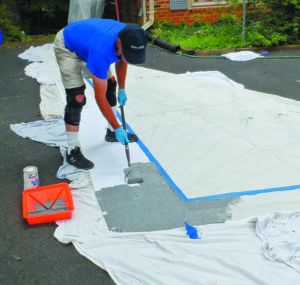
Can paint provide viable UV protection for sails, maybe even replacing the usual sun protection strip on furling genoas? North and Doyle have been offering paint as a UV protection option for several years, though it is a specialty item, typically reserved for light air sails and mega-yachts. We had some success from less expensive brands, and one brand of paint developed specifically for such a purpose quickly rose to the top.
The lone sail-specific paint in this test, Marine Shield lived up to our high expectations. Its performance in the flogging test was flawless. The coverage and appearance of this paint were very good, with very little light passing through.
The only observable difference between Marine Shield and the other paints we tested was higher gloss. Marine Shield is also slipperier, which should give it some advantage in furling and storage. The New Zealand product is not yet distributed in the U.S., though the company is working to line up a distributor.
This is not a project we’d recommend for the average cruising sailor. For most people, Sunbrella and Weather Max remain the gold standard for heavy duty UV covers for sails that live on a furler. The cloth outlasts the stitching that holds them, UV blocking is superior, and they provide physical protection and support. No other material offers this combination. But this protection is relatively heavy and expensive to replace.
UV Dacron and Tedlar films offer a lighter weight option. Self-adhesive fabric seems like a great DIY replacement option, but durability isn’t much better than paint, and sail shape can be affected when self-adhesive tapes are installed over large areas. This is particularly problematic with laminate sails and sails that are seriously creased and wrinkled.
We see a lot to like in using paint for old sails. It demonstrates good UV protection and surprising durability. The relatively low price make them a valid DIY option for the sailor who would rather save his beans for a new jib in five years than invest in a sewn cover for an old dog that is stretched out of shape.
We also see value of using paint on laminate sails that live part time on a furler, so long as you recognize that the UV protection is not perfect and that the sail should be put away when you are away from the boat for a few days.
Bottom line: Our Best Choice for a sail paint. Hopefully, it will become more widely available to DIY sailors. The true test will be durability over the next few years, but so far our experience with paint has been good.





































